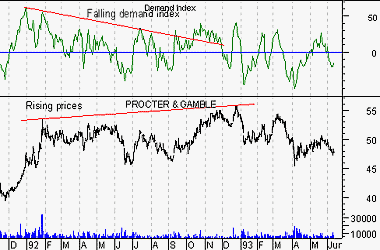
Technical Analysis from A to Z
by Steven B. Achelis
DEMAND INDEX
Overview
The Demand Index combines price and volume in such a way that it is often a leading indicator of price change. The Demand Index was developed by James Sibbet.
Interpretation
Mr. Sibbet defined six "rules" for the Demand Index:
- A divergence between the Demand Index and prices suggests an approaching weakness in price.
- Prices often rally to new highs following an extreme peak in the Demand Index (the Index is performing as a leading indicator).
- Higher prices with a lower Demand Index peak usually coincides with an important top (the Index is performing as a coincidental indicator).
- The Demand Index penetrating the level of zero indicates a change in trend (the Index is performing as a lagging indicator).
- When the Demand Index stays near the level of zero for any length of time, it usually indicates a weak price movement that will not last long.
- A large long-term divergence between prices and the Demand Index indicates a major top or bottom.
Example
The following chart shows Procter & Gamble and the Demand Index. A long-term bearish divergence occurred in 1992 as prices rose while the Demand Index fell. According to Sibbet, this indicates a major top.

Calculation
The Demand Index calculations are too complex for this book (they require 21-columns of data).
Sibbet's original Index plotted the indicator on a scale labeled +0 at the top, 1 in the middle, and -0 at the bottom. Most computer software makes a minor modification to the indicator so it can be scaled on a normal scale.
Contents
- Preface
- Acknowledgments
- Terminology
- To Learn More
- Bibliography
- About the Author
- Technical Analysis
- Price Fields
- Charts
- Support & Resistance
- Trends
- Moving Averages
- Indicators
- Market Indicators
- Line Studies
- Periodicity
- The Time Element
- Conclusion
- Absolute Breadth Index
- Accumulation/Distribution
- Accumulation Swing Index
- Advance/Decline Line
- Advance/Decline Ratio
- Advancing-Declining Issues
- Advancing, Declining, Unchanged Volume
- Andrews' Pitchfork
- Arms Index
- Average True Range
- Bollinger Bands
- Breadth Thrust
- Bull/Bear Ratio
- Candlesticks - Japanese
- CANSLIM
- Chaikin Oscillator
- Commodity Channel Index
- Commodity Selection Index
- Correlation Analysis
- Cumulative Volume Index
- Cycles
- Demand Index
- Detrended Price Oscillator
- Directional Movement
- Dow Theory
- Ease of Movement
- Efficient Market Theory
- Elliott Wave Theory
- Envelopes (Trading Bands)
- Equivolume/Candlevolume
- Fibonacci Studies
- Four Percent Model
- Fourier Transform
- Fundamental Analysis
- Gann Angles
- Herrick Payoff Index
- Interest Rates
- Kagi
- Large Block Ratio
- Linear Regression Lines
- MACD
- Mass Index
- McClellan Oscillator
- McClellan Summation Index
- Median Price
- Member Short Ratio
- Momentum
- Money Flow Index
- Moving Averages
- Negative Volume Index
- New Highs-Lows Cumulative
- New Highs-New Lows
- New Highs/Lows Ratio
- Odd Lot Balance Index
- Odd Lot Purchases/Sales
- Odd Lot Short Ratio
- On Balance Volume
- Open Interest
- Open-10 TRIN
- Option Analysis
- Overbought/Oversold
- Parabolic SAR
- Patterns
- Percent Retracement
- Performance
- Point & Figure
- Positive Volume Index
- Price and Volume Trend
- Price Oscillator
- Price Rate-of-Change
- Public Short Ratio
- Puts/Calls Ratio
- Quadrant Lines
- Relative Strength, Comparative
- Relative Strength Index
- Renko
- Speed Resistance Lines
- Spreads
- Standard Deviation
- STIX
- Stochastic Oscillator
- Swing Index
- Three Line Break
- Time Series Forcast
- Tirone Levels
- Total Short Ratio
- Trade Volume Index
- Trendlines
- TRIX
- Typical Price
- Ultimate Oscillator
- Upside/Downside Ratio
- Upside/Downside Volume
- Vertical Horizonal Filter
- Volatility, Chaikin's
- Volume
- Volume Oscillator
- Volume Rate-of-Change
- Weighted Close
- Williams' Accumulation/Distribution
- Williams' %R
- Zig Zag